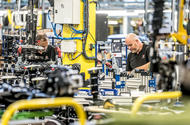Lower raw materials will help make EVs more affordable said Stellantis CEO Carlos Tavares
Pessimism around electric vehicles is pushing down cost of the materials needed to make them
Car companies are not loving the negativity around consumer demand for electric vehicles right now.
However it does have one major advantage – pushing down prices of the materials needed to make them.
Which, as Stellantis CEO Carlos Tavares pointed out recently, helps his company nicely. “Many people are talking about the slowdown on the BEV demand, which has had a huge impact on the raw material cost,” he said. “That is helping us to reduce the total production cost on BEVs faster than the ICE [internal combustion engine].”
Lower raw materials will help make EVs more affordable, solving one of the main pain points in the switch away from fossil fuels. “There will be a reverse situation at one point in time,” Tavares said.
Right now carmakers are cutting the overall purchase cost of electric cars, but this discounting is coming at the expense of profit margins. Research by Autocar’s sibling brand WhatCar? shows that EV discounts have increased 204% since January 2023 as carmakers rush to comply with the UK requirement to sell 22% zero-emission cars in 2024. As a result, sales of BEVs in the UK continued to rise in January.
Many will be sold at a loss, but a greater proportion won’t be thanks to the fall in the price of materials needed to build them, and specifically the lithium ion battery inside. For example lithium carbonate prices have now fallen 80% since 2022.
This has resulted in a 14% year-on-year drop in the price of automotive batteries, according to an annual survey conducted by energy analyst Bloomberg NEF late last year. It found that pack prices had fallen to a record low of $139/kWh (£110), with lithium iron phosphate (LFP) battery packs even lower at $130/kWh.
The falling prices were “driven by raw material and component prices falling as production capacity increased across all parts of the battery value chain,” the BNEF report stated. Meanwhile “demand growth fell short of some industry expectations”
Like other commodities, prices of battery metals are driven by forward predictions as much as current demand. Commodities futures are essentially a bet on what the material will be worth, so gloominess creates discounts. For example Russia’s invasion of Ukraine in 2022 triggered a spike in prices as traders feared disruption to supply, with nickel at point surpassing $100,000 per metric ton. It’s currently at $17,601.
That is cheering up car companies tremendously as they double their efforts to strip out costs of expensive electric vehicles. “The raw material costs within the battery supply chain have changed dramatically in the last year,” Rivian CEO RJ Scaringe told investors in February. “So that has a very significant impact on our overall cost structure.”
Renault saw the price of raw materials take a 350 million euro (£200 million) bite out of profits in the first half of last year, but by the second half that had partly reversed to the point that the final year hit fell to 216 million euros. “The pressure is now easing very significantly,” said Renault’s chief financial officer Thierry Pieton.
Renault is one of a handful of manufacturers who have reduced the list price of electric cars, rather than just discount them. For example in November it took £2500 off the price of the Megane E-Tech to start at £34,495 and more recently added an entry-level version of the new Scenic, effectively slashing the family SUV’s price by £3500 to £37,495. “The important message is we do cost reduction first, and then we do the pricing reduction after that to try to protect the margin of the car,” Pieton said.
Renault meanwhile has promised to take 40% out of the cost of future generation of EVs, starting with the Twingo city car.
Other previously painful car-making bills are falling too. JLR for example booked a £271 million boost from falling costs in the three months ending December 31, mainly due to the fact it didn’t have to pay exorbitant sums to brokers just to secure enough semiconductors.
Renault also noted a recent fall in two other cost spikes all car makers have had to suffer in the last couple of years – logistics and energy – while also pointing out they were still high.
BNEF predicts battery pack prices will continue on their path downward, hitting $113 in 2025 and $80/kWh in 2030. That remains substantial. It means a 50kWh pack will still be a huge $4000 entry into the final cost bill for a small car, but less than almost $7000 now.
As the Chinese start to come to close to price parity with combustion engine vehicles, Mercedes-Benz is warning that it will take longer for others. “It’s no secret that the variable cost of the battery electric vehicle sits significantly above what we were used to on the combustion side,” said CEO Ola Kallenius last month. “And it will remain so for the foreseeable future.”
However the fall in materials cost has given car makers hope that, barring another black swan event like the Russian invasion, the task of making EVs both affordable AND profitable has got a bit easier. Renault’s Pieton delivered the good news to investors last month, saying: “The big change..is that the cost of goods sold is finally going to become a tailwind overall, which it hasn’t been for three or four years now.”







